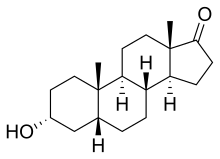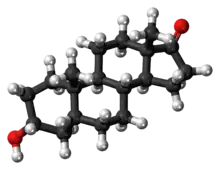Etiocholanolone
 | |
 | |
| Clinical data | |
|---|---|
| Other names | Aetiocholanolone 5-Isoandrosterone |
| ATC code |
|
| Identifiers | |
IUPAC name
| |
| CAS Number | |
| PubChem CID | |
| DrugBank | |
| ChemSpider | |
| UNII | |
| ChEBI | |
| ChEMBL | |
| Chemical and physical data | |
| Formula | C19H30O2 |
| Molar mass | 290.447 g·mol−1 |
| 3D model (JSmol) | |
SMILES
| |
InChI
| |
| | |
Etiocholanolone, also known as 5β-androsterone, as well as 3α-hydroxy-5β-androstan-17-one or etiocholan-3α-ol-17-one, is an etiocholane (5β-androstane) steroid as well as an endogenous 17-ketosteroid that is produced from the metabolism of testosterone. It causes fever, immunostimulation, and leukocytosis, and is used to evaluate adrenal cortex function, bone marrow performance, and in neoplastic disease to stimulate the immune system. Etiocholanolone is also known to be an inhibitory androstane neurosteroid,[1] acting as a positive allosteric modulator of the GABAA receptor,[2] and possesses anticonvulsant effects.[3] The unnatural enantiomer of etiocholanolone is more potent as a positive allosteric modulator of GABAA receptors and as an anticonvulsant than the natural form.[4]
Etiocholanolone is produced from 5β-dihydrotestosterone, with 3α,5β-androstanediol as an intermediate.
Chemistry
See also
- Androsterone
- Epiandrosterone
- Epietiocholanolone
- Etiocholanolone glucuronide
References
- ↑ Reddy DS (2010). Neurosteroids: endogenous role in the human brain and therapeutic potentials. Prog. Brain Res. Progress in Brain Research. Vol. 186. pp. 113–37. doi:10.1016/B978-0-444-53630-3.00008-7. ISBN 9780444536303. PMC 3139029. PMID 21094889.
- ↑ Li P, Bracamontes J, Katona BW, Covey DF, Steinbach JH, Akk G (June 2007). "Natural and enantiomeric etiocholanolone interact with distinct sites on the rat alpha1beta2gamma2L GABAA receptor". Mol. Pharmacol. 71 (6): 1582–90. doi:10.1124/mol.106.033407. PMC 3788649. PMID 17341652. S2CID 44286086.
- ↑ Kaminski RM, Marini H, Kim WJ, Rogawski MA (June 2005). "Anticonvulsant activity of androsterone and etiocholanolone". Epilepsia. 46 (6): 819–27. doi:10.1111/j.1528-1167.2005.00705.x. PMC 1181535. PMID 15946323.
- ↑ Zolkowska D, Dhir A, Krishnan K, Covey DF, Rogawski MA (September 2014). "Anticonvulsant potencies of the enantiomers of the neurosteroids androsterone and etiocholanolone exceed those of the natural forms". Psychopharmacology. 231 (17): 3325–32. doi:10.1007/s00213-014-3546-x. PMC 4134984. PMID 24705905.